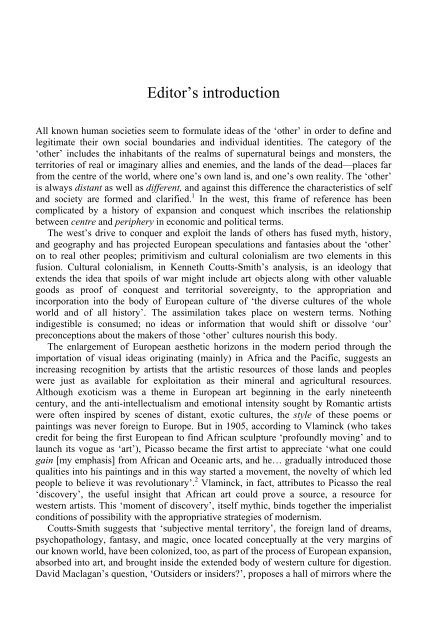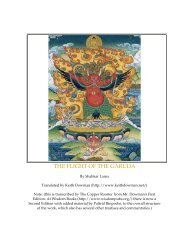Hiller - The Myth of Primitivism. Perspectives on Art - Esoteric Online
Hiller - The Myth of Primitivism. Perspectives on Art - Esoteric Online
Hiller - The Myth of Primitivism. Perspectives on Art - Esoteric Online
Create successful ePaper yourself
Turn your PDF publications into a flip-book with our unique Google optimized e-Paper software.
Editor’s introducti<strong>on</strong><br />
All known human societies seem to formulate ideas <str<strong>on</strong>g>of</str<strong>on</strong>g> the ‘other’ in order to define and<br />
legitimate their own social boundaries and individual identities. <str<strong>on</strong>g>The</str<strong>on</strong>g> category <str<strong>on</strong>g>of</str<strong>on</strong>g> the<br />
‘other’ includes the inhabitants <str<strong>on</strong>g>of</str<strong>on</strong>g> the realms <str<strong>on</strong>g>of</str<strong>on</strong>g> supernatural beings and m<strong>on</strong>sters, the<br />
territories <str<strong>on</strong>g>of</str<strong>on</strong>g> real or imaginary allies and enemies, and the lands <str<strong>on</strong>g>of</str<strong>on</strong>g> the dead—places far<br />
from the centre <str<strong>on</strong>g>of</str<strong>on</strong>g> the world, where <strong>on</strong>e’s own land is, and <strong>on</strong>e’s own reality. <str<strong>on</strong>g>The</str<strong>on</strong>g> ‘other’<br />
is always distant as well as different, and against this difference the characteristics <str<strong>on</strong>g>of</str<strong>on</strong>g> self<br />
and society are formed and clarified. 1 In the west, this frame <str<strong>on</strong>g>of</str<strong>on</strong>g> reference has been<br />
complicated by a history <str<strong>on</strong>g>of</str<strong>on</strong>g> expansi<strong>on</strong> and c<strong>on</strong>quest which inscribes the relati<strong>on</strong>ship<br />
between centre and periphery in ec<strong>on</strong>omic and political terms.<br />
<str<strong>on</strong>g>The</str<strong>on</strong>g> west’s drive to c<strong>on</strong>quer and exploit the lands <str<strong>on</strong>g>of</str<strong>on</strong>g> others has fused myth, history,<br />
and geography and has projected European speculati<strong>on</strong>s and fantasies about the ‘other’<br />
<strong>on</strong> to real other peoples; primitivism and cultural col<strong>on</strong>ialism are two elements in this<br />
fusi<strong>on</strong>. Cultural col<strong>on</strong>ialism, in Kenneth Coutts-Smith’s analysis, is an ideology that<br />
extends the idea that spoils <str<strong>on</strong>g>of</str<strong>on</strong>g> war might include art objects al<strong>on</strong>g with other valuable<br />
goods as pro<str<strong>on</strong>g>of</str<strong>on</strong>g> <str<strong>on</strong>g>of</str<strong>on</strong>g> c<strong>on</strong>quest and territorial sovereignty, to the appropriati<strong>on</strong> and<br />
incorporati<strong>on</strong> into the body <str<strong>on</strong>g>of</str<strong>on</strong>g> European culture <str<strong>on</strong>g>of</str<strong>on</strong>g> ‘the diverse cultures <str<strong>on</strong>g>of</str<strong>on</strong>g> the whole<br />
world and <str<strong>on</strong>g>of</str<strong>on</strong>g> all history’. <str<strong>on</strong>g>The</str<strong>on</strong>g> assimilati<strong>on</strong> takes place <strong>on</strong> western terms. Nothing<br />
indigestible is c<strong>on</strong>sumed; no ideas or informati<strong>on</strong> that would shift or dissolve ‘our’<br />
prec<strong>on</strong>cepti<strong>on</strong>s about the makers <str<strong>on</strong>g>of</str<strong>on</strong>g> those ‘other’ cultures nourish this body.<br />
<str<strong>on</strong>g>The</str<strong>on</strong>g> enlargement <str<strong>on</strong>g>of</str<strong>on</strong>g> European aesthetic horiz<strong>on</strong>s in the modern period through the<br />
importati<strong>on</strong> <str<strong>on</strong>g>of</str<strong>on</strong>g> visual ideas originating (mainly) in Africa and the Pacific, suggests an<br />
increasing recogniti<strong>on</strong> by artists that the artistic resources <str<strong>on</strong>g>of</str<strong>on</strong>g> those lands and peoples<br />
were just as available for exploitati<strong>on</strong> as their mineral and agricultural resources.<br />
Although exoticism was a theme in European art beginning in the early nineteenth<br />
century, and the anti-intellectualism and emoti<strong>on</strong>al intensity sought by Romantic artists<br />
were <str<strong>on</strong>g>of</str<strong>on</strong>g>ten inspired by scenes <str<strong>on</strong>g>of</str<strong>on</strong>g> distant, exotic cultures, the style <str<strong>on</strong>g>of</str<strong>on</strong>g> these poems or<br />
paintings was never foreign to Europe. But in 1905, according to Vlaminck (who takes<br />
credit for being the first European to find African sculpture ‘pr<str<strong>on</strong>g>of</str<strong>on</strong>g>oundly moving’ and to<br />
launch its vogue as ‘art’), Picasso became the first artist to appreciate ‘what <strong>on</strong>e could<br />
gain [my emphasis] from African and Oceanic arts, and he… gradually introduced those<br />
qualities into his paintings and in this way started a movement, the novelty <str<strong>on</strong>g>of</str<strong>on</strong>g> which led<br />
people to believe it was revoluti<strong>on</strong>ary’. 2 Vlaminck, in fact, attributes to Picasso the real<br />
‘discovery’, the useful insight that African art could prove a source, a resource for<br />
western artists. This ‘moment <str<strong>on</strong>g>of</str<strong>on</strong>g> discovery’, itself mythic, binds together the imperialist<br />
c<strong>on</strong>diti<strong>on</strong>s <str<strong>on</strong>g>of</str<strong>on</strong>g> possibility with the appropriative strategies <str<strong>on</strong>g>of</str<strong>on</strong>g> modernism.<br />
Coutts-Smith suggests that ‘subjective mental territory’, the foreign land <str<strong>on</strong>g>of</str<strong>on</strong>g> dreams,<br />
psychopathology, fantasy, and magic, <strong>on</strong>ce located c<strong>on</strong>ceptually at the very margins <str<strong>on</strong>g>of</str<strong>on</strong>g><br />
our known world, have been col<strong>on</strong>ized, too, as part <str<strong>on</strong>g>of</str<strong>on</strong>g> the process <str<strong>on</strong>g>of</str<strong>on</strong>g> European expansi<strong>on</strong>,<br />
absorbed into art, and brought inside the extended body <str<strong>on</strong>g>of</str<strong>on</strong>g> western culture for digesti<strong>on</strong>.<br />
David Maclagan’s questi<strong>on</strong>, ‘Outsiders or insiders?’, proposes a hall <str<strong>on</strong>g>of</str<strong>on</strong>g> mirrors where the




